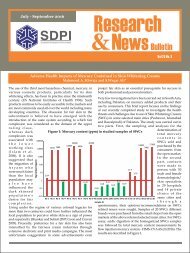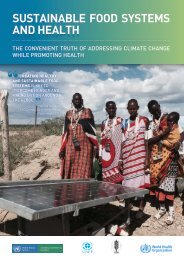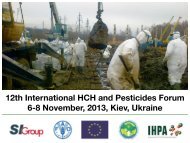Women and Chemicals
WomenAndChemicals_PublicationIWD2016
WomenAndChemicals_PublicationIWD2016
Create successful ePaper yourself
Turn your PDF publications into a flip-book with our unique Google optimized e-Paper software.
Why women?<br />
Gender <strong>and</strong> other<br />
social determinants<br />
Roles <strong>and</strong> tasks of women <strong>and</strong> men<br />
In all societies, women <strong>and</strong> men have different gender roles,<br />
which also impact their exposure to chemicals. There is limited<br />
hard data <strong>and</strong> exact figures on how the different gender roles<br />
expose women <strong>and</strong> men in a different manner to chemicals.<br />
More research is required to attain information such as absolute<br />
numbers of exposed women, exposure pathways, typical chemicals<br />
<strong>and</strong> their effect on women’s health.<br />
As well as their paid occupations, other core female tasks are<br />
childbearing, child rearing <strong>and</strong> running the household. Apart<br />
from the provision of health services <strong>and</strong> hygienic measures this<br />
includes activities such as the purchase of food <strong>and</strong> other products<br />
for daily life, for childcare <strong>and</strong> for housecleaning. This exposes<br />
women to many different kinds of chemicals other than<br />
men. On the other h<strong>and</strong> this role gives them some purchasing<br />
power as consumers. If women as consumers would be fully informed<br />
about harmful chemicals in the products they buy <strong>and</strong> if<br />
there are safer alternatives, they can play out this power effectively<br />
for their <strong>and</strong> their family’s health.<br />
Structural inequalities between women <strong>and</strong> men also play a<br />
role when looking at women <strong>and</strong> chemicals. Tasks related to providing<br />
food for the family, fostering children <strong>and</strong> sustaining a family<br />
depend very much on access to <strong>and</strong> ownership of l<strong>and</strong> <strong>and</strong><br />
other assets, such as finances <strong>and</strong> education. <strong>Women</strong> all over the<br />
world do not have the same level of control as men over these<br />
assets, due to their social status <strong>and</strong>/or traditional gender roles,<br />
including cultural <strong>and</strong> religious components. 24 This is even more<br />
the case for the growing number of female-headed households.<br />
Generally, women also have limited decision-making<br />
power compared to men. Female representation in political<br />
decision-making bodies illustrate this: according to statistics<br />
of the Inter-Parliamentary Union only 19 per cent of seats in<br />
parliaments worldwide are held by women. 25 Only around 6<br />
per cent of higher government positions, such as head of<br />
state or head of government, are assigned to women. These<br />
are average figures. However, they reflect a persistent gap in<br />
decision-making power between women <strong>and</strong> men. This is<br />
When it comes to differences in exposure to chemicals <strong>and</strong> pollutants,<br />
social factors are important. Social, economical <strong>and</strong> cul-<br />
tural factors strongly influence the chemicals women in different<br />
developmental stages are exposed to. Social determinants include,<br />
besides the gender aspect, socio economic status, occupational<br />
status, ethnicity, education, age, living conditions, geographical<br />
location, nutrition <strong>and</strong> others.<br />
perpetuated in smaller decision-making bodies on regional<br />
<strong>and</strong> local level, <strong>and</strong> the same pattern is visible for women in<br />
science <strong>and</strong> the private sector.<br />
There are also differences between men <strong>and</strong> women in relation<br />
to employment. Even though progress has been made in<br />
advancing gender equality on the employment sector, women<br />
continue to be discriminated against in terms of access to jobs,<br />
remuneration, benefits, working conditions <strong>and</strong> access to decision-making<br />
bodies. 26 Economic <strong>and</strong> financial crises had their effects<br />
on women <strong>and</strong> men, in particular on poor <strong>and</strong> vulnerable<br />
groups. But they also pushed even more women into informal<br />
employment. 27 Many of these informal employment opportunities<br />
are directly or indirectly related to high exposure of harmful<br />
chemicals, like to work as a waste picker.<br />
According to the FAO, “women make essential contributions<br />
to the rural economy of all developing country regions as farmers,<br />
labourers <strong>and</strong> entrepreneurs”. 28 <strong>Women</strong> have an important role in<br />
the production of food. Rural women especially in developing<br />
countries often provide the food for their families by subsistence<br />
farming <strong>and</strong> by keeping livestock in close vicinity to their home. As<br />
providers of food, these women are highly dependent on natural<br />
resources <strong>and</strong> a sound environment. Therefore they are the first<br />
ones to be affected by the impacts of hazardous chemicals in the<br />
environment <strong>and</strong> especially by pesticides.<br />
11







